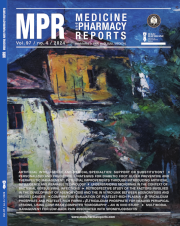Psychosocial impact of scars following total hip arthroplasty: a comparative study of traumatic vs. non-traumatic etiologies
DOI:
https://doi.org/10.15386/mpr-2748Keywords:
total hip arthroplasty, post-operative scars, psychometric scale, internalizationAbstract
Background. This study aims to assess the psychosocial impact of the scars resulting from total hip arthroplasties (THA) in terms of internalization and adaptation related to the etiology of the joint damage (traumatic versus non-traumatic) and the specific surgical procedure, by using a modern approach.
Methods. A prospective study was carried out between October 2020 and September 2022, at the Orthopedics department, Bihor Emergency County Clinical
Hospital in Oradea, located in North-west of Romania. Depending on diagnosis, the participants were divided into two relatively homogeneous groups: non-traumatic group with 113 subjects (55.66%) diagnosed with degenerative hip osteoarthritis and traumatic group with 90 (44.33%) patients who underwent total hip arthroplasty (THA) following a trauma.
Results. The highest internalization score was noted in uncemented THA cases performed as a consequence of traumatic coxarthrosis. The ANOVA coefficients of intergroup comparisons for the participants with traumatic coxarthrosis indicate that surgical procedures have a significant influence on scar internalization [F (2, 90) = 10.046; p<0.001; ƞ2=0.188]. Scheffe’s post hoc test indicated that patients with non-traumatic coxarthrosis who underwent uncemented THA procedures presented a higher level of psychosocial internalization compared to those who underwent cemented (Mdf = 3.87; p<0.02) and revision THA (Mdf = 4.60; p<0.004), but without surprising differences compared to revision of the soft tissue (Mdf = 3.31; p<0.08).
Conclusions. The relevance of the coxarthrosis etiology for subsequent surgical interventions was emphasized in this study. Coxarthrosis has a strong impact on the psychosocial internalization of postoperative scars, which indicates a change in the perception of social support as well as the perception of the quality of life.
Downloads
Published
How to Cite
Issue
Section
License
The authors are required to transfer the copyright of the published paper to the journal. This is done by agreeing to sign the Copyright Assignment Form. Whenever the case, authors are also required to send permissions to reproduce material (such as illustrations) from the copyright holder.

The papers published in the journal are licensed under a Creative Commons Attribution-NonCommercial-NoDerivatives 4.0 International License.

